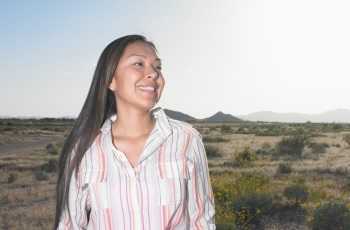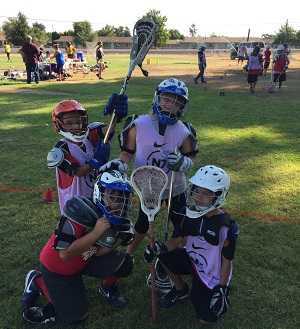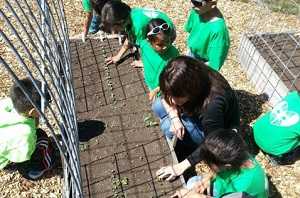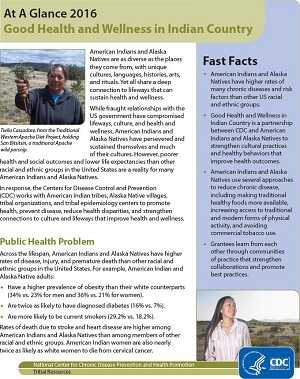Good Health and Wellness in Indian Country
At A Glance 2016
American Indians and Alaska Natives are as diverse as the places they come from, with unique cultures, languages, histories, arts, and rituals. Yet all share a deep connection to lifeways that can sustain health and wellness.
While fraught relationships with the US government have compromised lifeways, culture, and health and wellness, American Indians and Alaska Natives have persevered and sustained themselves and much of their cultures. However, poorer health and social outcomes and lower life expectancies than other racial and ethnic groups in the United States are a reality for many American Indians and Alaska Natives.
In response, the Centers for Disease Control and Prevention (CDC) works with American Indian tribes, Alaska Native villages, tribal organizations, and tribal epidemiology centers to promote health, prevent disease, reduce health disparities, and strengthen connections to culture and lifeways that improve health and wellness.
Public Health Problem
Across the lifespan, American Indians and Alaska Natives have higher rates of disease, injury, and premature death than other racial and ethnic groups in the United States. For example, American Indian and Alaska Native adults:
- Have a higher prevalence of obesity than their white counterparts (34% vs. 23% for men and 36% vs. 21% for women).
- Are twice as likely to have diagnosed diabetes (16% vs. 7%).
- Are more likely to be current smokers (29.2% vs. 18.2%).
Rates of death due to stroke and heart disease are higher among American Indians and Alaska Natives than among members of other racial and ethnic groups. American Indian women are also nearly twice as likely as white women to die from cervical cancer.
Many Native populations are affected by poverty, unemployment, poor housing, and low education, among other adversities. These afflictions result from historical insults, are often associated with poor health behaviors and disease management, and drive much of the excess burden of diseases and premature death. Nonetheless, many chronic disease can be prevented or mitigated by culturally relevant, community-driven policies, systems, and environmental improvements that support healthy choices and behaviors.
CDC’s Response
In 2014, the National Center for Chronic Disease Prevention and Health Promotion (NCCDPHP) created the Good Health and Wellness in Indian Country (GHWIC) program. GHWIC supports a coordinated, holistic approach to healthy living and chronic disease prevention and reinforces the work already under way in Indian Country to make healthy choices and lifeways easier for American Indians and Alaska Natives.
GHWIC is a 5-year program funded at $16 million in 2015. Twelve tribes work on a variety of health interventions and strategies alongside 11 tribal organizations and 12 tribal epidemiology centers (TECs). (See details below.)
GHWIC interventions focus on reducing tobacco use and exposure, improving nutrition and physical activity, increasing support for breastfeeding, increasing health literacy, and strengthening team-based health care and community-clinical links.
To improve the health behaviors and overall health of American Indians and Alaska Natives, GHWIC works in all of NCCDPHP’s four action areas or domains—epidemiology and surveillance, environmental approaches, health care system interventions, and community programs linked to clinical services.
Related Materials
Fast Facts
- American Indians and Alaska Natives have higher rates of many chronic diseases and risk factors than other US racial and ethnic groups.
- Good Health and Wellness in Indian Country is a partnership between CDC and American Indians and Alaska Natives to strengthen cultural practices and healthy behaviors that improve health outcomes.
- American Indians and Alaska Natives use several approaches to reduce chronic disease, including making traditional healthy foods more available, increasing access to traditional and modern forms of physical activity, and avoiding commercial tobacco use.
- Grantees learn from each other through communities of practice that strengthen collaborations and promote best practices.

How GHWIC Works
The 12 tribes funded by GHWIC use community-chosen and culturally adapted policies, systems, and environmental improvements to achieve GHWIC’s long-term goals to reduce rates of death and disability from tobacco use, reduce the prevalence of obesity, and reduce rates of death and disability from diabetes, heart disease, and stroke.
Eleven tribal organizations provide leadership, technical assistance, and resources to more than 100 other tribes and tribal organizations in their Indian Health Service (IHS) areas and to GHWIC funded tribes.
Eleven TECs serve tribes, villages, and tribal organizations in each IHS area to evaluate GHWIC interventions. They focus on demonstrating tribe and area-level impact. One TEC, the Urban Indian Health Institute, coordinates the national evaluation by providing support and expertise to other TECs, tribal organizations, tribes, and CDC.

The first-ever lacrosse tournament for the Yellowhawk community, hosted by the Xa’lish Lacrosse Youth Wellness Program.
Epidemiology and Surveillance
Epidemiology and surveillance are critical to the success of GHWIC. Grantees use assessments and data to plan interventions and monitor outcomes. Assessments may address topic areas ranging from the availability of healthy and traditional foods to the use of team-based care to prevent and manage chronic disease.
Program Spotlight: Red Cliff Band
The Red Cliff Band of Lake Superior Chippewa partnered with the Great Lakes Inter-Tribal Epidemiology Center to conduct surveys that included questions from the 2011 and 2012 Behavioral Risk Factor Surveillance System (BRFSS). Just over 300 participants completed the surveys through in-person interviews; 86% of participants were enrolled Red Cliff members.
Red Cliff will use tools and resources from GHWIC to analyze and interpret the data and make decisions about program needs in the community. Red Cliff is the first tribe in the Bemidji Area to complete a tribal BRFSS. The results will be critical to Red Cliff’s efforts to describe the health status of the community and monitor changes in health resulting from GHWIC efforts.
Environmental Approaches
Policy and environmental improvements make healthy choices more available, accessible, and affordable—and thus easier to do. Improving policies and community design can improve many health behaviors and help people avoid chronic diseases. For example, GHWIC grantees are increasing (1) the use of food service guidelines to improve the nutritional quality of foods served in schools, senior centers, and worksites; (2) support for breastfeeding in hospitals, worksites, and other organizations; and (3) opportunities for physical activity.
Program Spotlight: San Carlos Apache Tribe
The Traditional Western Apache Diet Project of the San Carlos Apache Tribe seeks to revitalize pre-reservation Apache food, health, and education systems as a way to reconnect the Apache people with Ni’gosdzán (the Earth Woman), their ancestral source of balance and happiness. For the Apache, health and healing systems are not just a matter of public health, they are ways of life that have power and resonance for the people today.
Program Spotlight: Yellowhawk Health Center
The Yellowhawk Health Center of the Confederated Tribes of the Umatilla Indian Reservation is implementing a walking program called Walk the Rez that is modeled after national walking programs and Let’s Move in Indian Country. The health center maps out trails and provides information about local landmarks, history, and lifeways of the Umatilla, Walla Walla, and Cayuse people. Participants who use the trails track their steps and submit their tally to the program. A community of sharing has formed as the number of participants enjoying physical activity and learning about their culture has increased. Top of Page
Health Care System Interventions
Health care system interventions aim to improve the delivery and use of clinical and other preventive services. GHWIC grantees are increasing the use of team-based care by (1) engaging health care “extenders,” such as community health representatives (CHRs), pharmacists, public health nurses, case managers, and patient navigators; (2) increasing the proportion of adults at high risk who participate in a CDC-recognized diabetes prevention program; and (3) increasing the number of adults protected from secondhand smoke because of tobacco-free policies.
Program Spotlight: Lower Brule Sioux Tribe
The community needs assessment conducted by the Lower Brule Sioux Tribe indicated that a majority of tribal employees who had been referred to the Diabetes Self-Management Education (DSME) program could not attend classes because of their work schedule. Many said they would exercise and attend the DSME classes offered at tribal worksites if they could. In August 2015, the Lower Brule Tribal Council approved a policy drafted by the diabetes director to allow tribal employees to attend DSME, physical activity, or community-sponsored events for 1 hour during working hours.
Of the 137 people with diagnosed diabetes in Lower Brule, 56 (41%) participated in tribal DSME classes in fiscal year 2015. Lower Brule expects that this leave policy will continue to increase participation in DSME classes, improve the health of tribal employees, and perhaps encourage others in the community to attend DSME classes and improve their diabetes management.
Community Programs Linked to Clinical Services
These interventions ensure that people with or at high risk of chronic diseases can access quality community resources to best manage their conditions. Grantees are engaging CHRs and other health care extenders that link patients to resources and promote chronic disease prevention and management.
Program Spotlight: Albuquerque Area Southwest Tribal
Epidemiology Center (AASTEC)
AASTEC partners with the University of New Mexico’s Project ECHO to train tribal CHRs in the 27 Albuquerque Area tribes to help tribal members prevent and manage type 2 diabetes, cardiovascular disease, stroke, and associated risk factors. The training is offered to as many as 25 tribal members twice a year during each of the 5 project years; up to 200 CHRs will eventually be mobilized.
These trained CHRs will work with community members with or at risk of chronic diseases to reduce their risks and improve their health. Tribal members who work with the CHRs will be followed over time to understand the extent to which the training improved the CHRs’ ability to motivate clients to make behavior changes.

Children in the Confederated Tribes of the Umatilla Indian Reservation Head Start program tend their first outdoor garden and learn the importance of healthy eating.
Future Directions
Through GHWIC and other programs, NCCDPHP strives to partner with Native communities to strengthen healthy lifeways and promote practices that keep American Indians and Alaska Natives well. The program is designed to expand by working with more tribes directly and extending its reach and impact through tribal organizations, should more funding become available.
Because solutions to public health problems already exist in Indian Country, GHWIC grantees participate with CDC and other partners in “communities of practice” that promote peer-to-peer learning and problem solving. Grantees regularly share their program activities, successes, and challenges. These communities of practice have strengthened collaborations among grantees and CDC.
By building the infrastructure to support culturally appropriate, effective public health approaches and better address the long-standing challenges to healthy behaviors and lifeways, American Indians and Alaska Natives can make sustainable gains in health and quality of life.
- Page last reviewed: March 3, 2016
- Page last updated: March 3, 2016
- Content source:



 ShareCompartir
ShareCompartir
